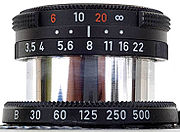
Zeiss formula
Encyclopedia

Photography
Photography is the art, science and practice of creating durable images by recording light or other electromagnetic radiation, either electronically by means of an image sensor or chemically by means of a light-sensitive material such as photographic film...
optics
Optics
Optics is the branch of physics which involves the behavior and properties of light, including its interactions with matter and the construction of instruments that use or detect it. Optics usually describes the behavior of visible, ultraviolet, and infrared light...
, the Zeiss formula is a supposed formula for computing a circle of confusion
Circle of confusion
In optics, a circle of confusion is an optical spot caused by a cone of light rays from a lens not coming to a perfect focus when imaging a point source...
(CoC) criterion for depth of field
Depth of field
In optics, particularly as it relates to film and photography, depth of field is the distance between the nearest and farthest objects in a scene that appear acceptably sharp in an image...
(DoF) calculations. The formula is
 , where
, where  is the diagonal measure of a camera format, film, sensor, or print, and
is the diagonal measure of a camera format, film, sensor, or print, and  the maximum acceptable diameter of the circle of confusion.
the maximum acceptable diameter of the circle of confusion.The Zeiss formula is apocryphal, in the sense that it has grown to be a well-known named concept by propagation through the internet, even though it has no official origin, little connection to Carl Zeiss Company, and no recognition or usage in the photographic industry outside the web community.
The number 1/1730 derives from a circle of confusion diameter of 0.025 mm on a full-frame 35 mm film format
Film format
A film format is a technical definition of a set of standard characteristics regarding image capture on photographic film, for either stills or movies. It can also apply to projected film, either slides or movies. The primary characteristic of a film format is its size and shape.In the case of...
, with diagonal size about 43.25 mm (43.25/0.025 is 1730). The CoC size of 0.025 mm for this format appears in Jacobson's Photographic Lenses Tutorial,
and the 1730 in his 1996 Photographic Lenses FAQ.
Jacobson derived the 0.025 mm CoC number from analysis of the Zeiss Triotar lens DoF markings on the Rollei B35 (see photo). The manual for the Rollei B35 also states 0.025 mm CoC for its tabulated DoF distances, though it also includes an example DoF reading that implies a larger CoC.
By 2001, the term "Zeiss formula" had appeared, in the manual for the on-line DoF calculator f/calc.
On the other hand, Zeiss gives the values d/1000 as the traditional standard and d/1500 as the modern standard.

